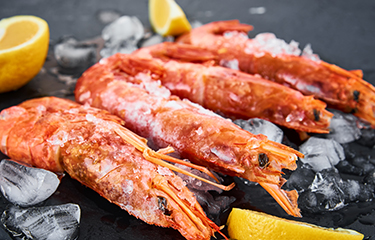Argentine red shrimp find seasonal favor in Japan

Argentine red shrimp have become a popular item during Japanese New Year, with seasonal demand pushing imports of the species to the top of the charts.
Head-on prawns are a traditional part of the Japanese New Year menu – whole boiled shrimp represent long life, with the curved body and long antennae symbolizing the stooped back and long whiskers of an old man.
Demand for Argentine red shrimp spiked in November 2021 as importers in Japan stock up on the species in advance of the holiday. Customs data showed imports of shrimp from Argentina – excluding lobster and spiny lobster – amounted to 2.4 million kilograms, valued at JPY 2.6 billion (USD 22.4 million, EUR 19.9 million). That bump ranked Argentina above Indonesia – typically Japan’s third-largest supplier – in shrimp exports to Japan for the month.
Costco Wholesale Japan, a subsidiary of the U.S. corporation and based in Kawasaki City (but moving to Kisarazu City, Chiba Prefecture this summer), regularly features whole Argentine red shrimp (Pleoticus muelleri), both raw in the seafood section and cooked as a topping for prepared paella.
Argentine red shrimp are offered widely at shops on the Rakuten online marketplace year-round, in a range of sizes from L1 to L3, (L1: 10/20 prawns per kilogram, L2: 20/30 prawns per kilogram, L3: 30/40 prawns per kilogram) with L1 the most-common and -popular in Japan.
While Indian suppliers offer large head-on, shell-on (HOSO) shrimp as well, Argentine red shrimp can be found at a more reasonable price. Large black tiger shrimp from India often go to a third country, such as Vietnam, for processing and then on to the U.S., which is willing to pay more than Japan.
Despite the spike in demand in November 2021, import volumes of Argentine red shrimp were actually down from the same month in 2020, when the total approached 4 million kilograms, valued at JPY 3.2 billion (USD 27.7 million, EUR 24.8 million), That huge total made Argentina the single-biggest source of shrimp, by both weight and value, for Japan in that month.
While much-loved in Japan due to its unique flavor, Argentine red shrimp has not yet achieve status as a year-round staple. Its import and sales are highly seasonal, and it does not compete directly with farmed prawns from Southeast Asia, which are usually sold headless and for which demand is steady.
In 2021, the top countries exporting shrimp to Japan were India (27 percent market share), Vietnam (17 percent), Indonesia (15 percent) and Argentina (10 percent). The market shares didn’t change much from year 2020, when the shares were: India at 25 percent, Vietnam at 18 percent, Indonesia at 15 percent, and Argentina at 10 percent.
Part of the decrease in Argentine red shrimp demand may be related to supply. Revista Puerto reported that during the peak catch period of December 2021 through January 2022, landings at the main port of Rawson fell. The fishery in province of Chubut, of which Rawson is the capital, in December 2021, had the lowest catch for that month in three years, while landings in January 2022 were the lowest in five years. While the season doesn’t end entirely in January, its peak has now passed, meaning it is unlikely that catches will pick up to previous levels.
The lower landings can be partly attributed to many periods of bad weather, as confirmed by the fact that the shortfall was mostly among smaller vessels in the artisanal fleet, which were more likely to stay in port to avoid rough seas. However, there is also concern that the lower catch may reflect over-exploitation of the resource. It was difficult this year to locate shrimp in thicker concentrations, thus requiring multiple sets, according to Revista Puerto.
Landings in December 2020, in contrast, were quite high. While there is some concern of overfishing, this species is known to have considerable annual variability in the stock. It has a short lifespan of a year to 18 months, and so the current stock largely depends on how favorable the environmental conditions are for recruitment.
The reproductive ability of the shrimp is great. A report by the National Institute for Fisheries Research and Development found, if conditions for survival are favorable, a large rebound is possible.
The fishery is managed under two fishery improvement projects (FIPs), both sponsored by the non-profit CeDePesca. These are the Argentine red shrimp on-shore FIP and the Argentine red shrimp off-shore FIP.
Photo courtesy of Lazy_Bear/Shutterstock






Share